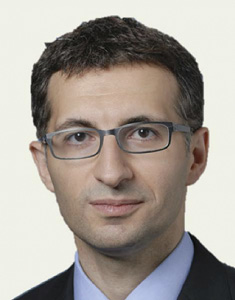
The description of subclinical leaflet thrombosis following transcatheter aortic valve implantation (TAVI) created great drama and controversy for the field because of a potential association with cerebral embolic disease1; however, subsequent systematic studies have alleviated such concerns2,3. Transcatheter mitral valve implantation (TMVI) (using a balloon-expandable transcatheter SAPIEN prosthesis [Edwards Lifesciences, Irvine, CA, USA]) is a highly effective, minimally invasive treatment for degenerated mitral bioprostheses, but may also be applied to native leaflet failure in the presence of a surgical mitral ring or mitral annular calcification (MAC)4. Studies with dedicated prostheses are continuing for TMVI in native mitral valves in the absence of a surgical ring or calcium.
Transcatheter heart valve thrombosis (THVT) in the aortic position
Chakravarty et al studied THVT and found the frequency of reduced leaflet motion (RLM) following surgical aortic bioprosthesis implantation to be 4% and that following TAVI to be 4-40%, depending on the prosthesis studied3. Although there was no clinically important impact on death or stroke, there was a suggestion that RLM could be linked to rises in transvalvular gradients. Subsequent low-risk TAVI studies, including PARTNER and Evolut2,5, demonstrated neither a significant link to thromboembolic disease nor premature valve failure, albeit with a short timeframe of follow-up.
THVT in the mitral position
It has been postulated that the lower flow state (an important component of Virchow’s triad), as well as the need for larger prostheses, may render the mitral position more thrombotic to bioprostheses than the aortic position. However, data on mitral bioprostheses remain limited.
In this issue of EuroIntervention, Kikoïne et al present their study on the phenomenon of leaflet thrombosis with serial transoesophageal echocardiography (TOE) or computed tomography (CT) scans following TMVI in 130 patients6.
Although the majority of the patients studied received some form of anticoagulation, they found leaflet thrombosis in 12.3% of the patients, and this was predominantly immediate. In cases that were immediate, shock was an important association. In cases that were early or late (before or after three months post procedure), absence of anticoagulation emerged as the most important risk factor.
A mandate for lifelong anticoagulation?
Importantly, the vast majority of patients were on anticoagulation, 88.5% at “early” (within three months post procedure) follow-up and 70.7% beyond that time point. It is reasonable to assume that the frequency of THVT could increase further on withdrawal of anticoagulation. Many mitral patients have co-existing atrial fibrillation (AF; 60% in the present series, 33-62% in recent TMVI studies7), which also commits them to anticoagulation. However, that paradigm is changing with the expansion of indications for left atrial appendage occlusion (LAAO). Although the inaugural LAAO studies excluded valvular AF, LAAO is under investigation in the setting of TAVI and AF8. It remains unclear whether a three-month course of anticoagulation will be adequate for TMVI and so this will be an important caveat and should be factored into the decision-making process.
Although the authors found immediate THVT to be associated with shock, early and late THVT were not statistically linked to early adverse clinical endpoints, including 30-day death and stroke. However, it is difficult to draw definitive conclusions on this since the study was underpowered and the follow-up short. Indeed, although the 30-day mortality was not statistically different in the presence/absence of THVT (p=0.25), it was numerically more than twofold higher in the THVT group (12.5% vs 5.3%), which cannot be dismissed and demands further close scrutiny in future studies.
Will THVT further limit the expansion of TMVI in native mitral regurgitation (MR)?
While THVT and a potential need for long-term anticoagulation may not affect the Heart Team’s decision for patients undergoing valve-in-valve (ViV), for native MR it will be an important consideration, particularly if patients are in sinus rhythm. Transcatheter mitral repair technology has grown exponentially in recent years, particularly edge-to-edge (E2E) repair, with the MitraClip® device (Abbott Vascular, Santa Clara, CA, USA) and, more recently, the PASCAL device (Edwards Lifesciences). Moreover, many dedicated TMVI are larger, with greater prosthetic leaflet surface areas, which could render them even more susceptible to THVT.
If a replacement technology has the possibility of a lifetime sentence to anticoagulation, repair therapies such as E2E may seem all the more attractive, particularly to an ageing population who may be susceptible to falls and bleeding risk. Indeed, we saw from the GALILEO study9 that a systematic anticoagulation approach increases the risk of major bleeding and death in the TAVI population; the TMVI population is probably susceptible to the same risks.
Conclusion
Although TMVI is the dominant treatment modality for degenerated prostheses (ViV), TMVI for native MR already has substantial anatomical limitations that may exclude up to two thirds of patients. The high rates of THVT seen in the present and other TMVI studies, with an associated commitment to long-term anticoagulation, lends further credence to a transcatheter “think repair first” approach that increasingly mirrors the favoured surgical paradigm for native MR; the plot thickens on the mitral stage.
Conflict of interest statement
H. Jilaihawi reports grant/research support from Abbott Vascular, Bracco, Edwards Lifesciences and Medtronic, and consulting fees/honoraria from Boston Scientific, Edwards Lifesciences and Medtronic.
Supplementary data
To read the full content of this article, please download the PDF.

